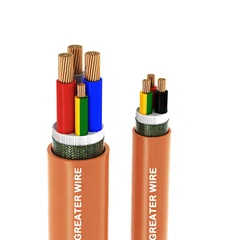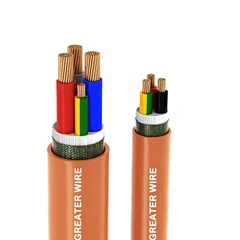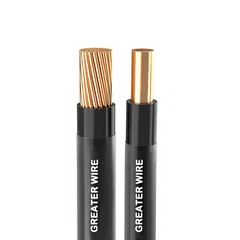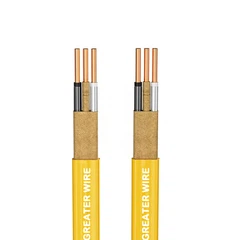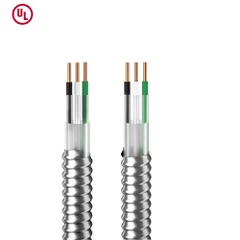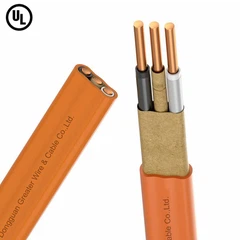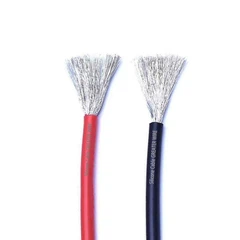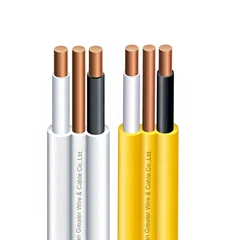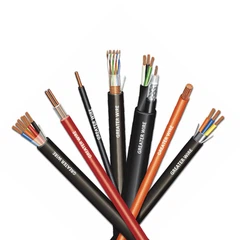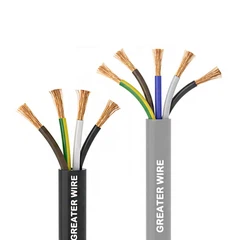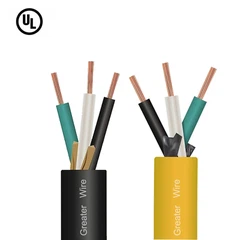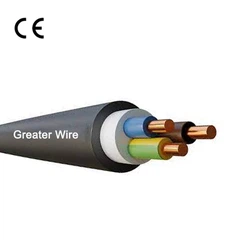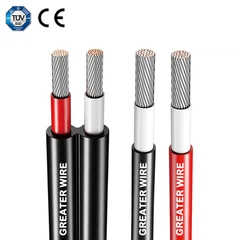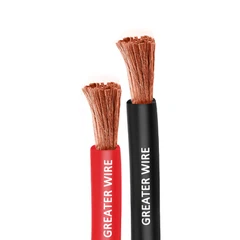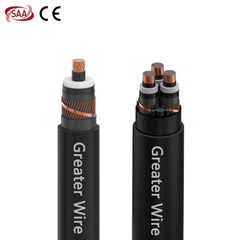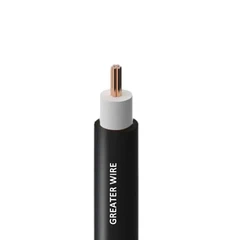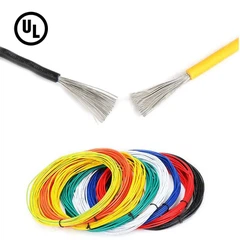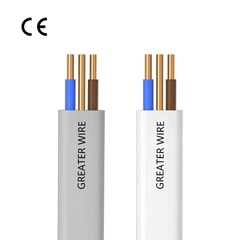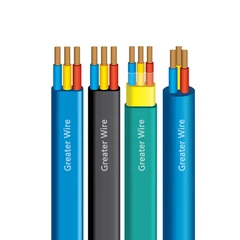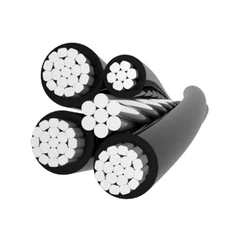1. RW90 Cable Structure and Performance Explained
1.1 Conductor Materials: Choosing Between rw90 aluminum wire and rw90 copper
RW90 cables are classified into two main types based on conductor material:
rw90 aluminum wire: Lightweight, cost-effective, and easy to install. Ideal for large-scale projects focused on budget control.
rw90 copper: Offers superior conductivity and corrosion resistance, making it ideal for high-safety or high-current density environments.
These two conductor types offer a balance between performance and cost, allowing users to select the most appropriate solution based on specific needs.
1.2 Insulation Material: Cross-linked Polyethylene (XLPE)
RW90 cables use XLPE (Cross-linked Polyethylene) insulation, which offers several advantages:
High thermal resistance (up to 90°C continuous operating temperature)
Excellent electrical insulation
Strong resistance to moisture and chemical corrosion
This insulation material is one of the key features that distinguishes RW90 from traditional electrical cables.
1.3 Common Sizes and rw90 cable specifications
RW90 cables are available in a wide range of sizes - from 6 AWG to 750 kcmil, suitable for residential, commercial, and industrial applications. For example:
Residential grounding and distribution: 8 AWG or 6 AWG copper
Commercial equipment: 2 AWG or 1/0 AWG
Industrial feeders: 4/0 AWG, 250 kcmil, or larger
RW90 cables are also available in different insulation colors, making it easier to identify circuits and phases during installation.
2. Can RW90 Be Directly Buried?
According to the Canadian Electrical Code (CEC) and National Electrical Code (NEC) in the U.S., RW90 cables cannot be installed directly underground without conduit. Here's why:
2.1 RW90's Intended Use
RW90 is designed for use in dry or damp locations where it is installed in conduit. Although XLPE insulation is moisture-resistant, RW90 lacks an outer protective jacket and is not engineered to withstand long-term exposure to soil, sharp objects, insects, or groundwater when buried directly.
2.2 NEC/CEC Code Requirements
Electrical codes stipulate that underground cables must meet one of the following:
Have an outer jacket and mechanical protection (e.g., TECK90, USEB cables)
Be installed within approved underground conduit (e.g., PVC, HDPE, or metal conduit)
RW90 does not meet the first condition but can be legally used underground if properly installed in conduit.
3. How to Safely Install RW90 Underground
Since RW90 cannot be used for direct burial, how can it be safely installed underground? The following are best practices:
3.1 Use Waterproof Conduit
To ensure safety and code compliance, RW90 must be installed in one of the following conduit types:
PVC Conduit (Schedule 40 or 80): Corrosion-resistant and easy to install
HDPE Conduit: Flexible and suitable for routes with multiple bends
Metal Conduit (RMC/IMC): Offers high mechanical strength for heavy-duty environments
The chosen conduit must provide resistance to moisture, pressure, and corrosion to protect the RW90 cable inside.
3.2 Recommended Burial Depths
While specific requirements vary by region, general guidelines for conduit burial depth are:
Residential areas: Minimum 450 mm (18 inches)
Industrial areas or under driveways: Minimum 600 mm (24 inches) or deeper
It's also recommended to place warning tape or labels above the conduit to prevent accidental damage during future digging or construction work.
3.3 Heat Dissipation Considerations
RW90 cables generate heat during operation. If multiple cables are tightly packed in a sealed conduit, heat buildup may occur. It's important to calculate ampacity derating to ensure safe operation.
Derating ensures that the electrical system runs efficiently and avoids overheating, which could damage insulation or reduce cable lifespan.
4. Advantages of Using RW90 for Underground Installations
Even though RW90 cannot be directly buried, it remains an ideal choice for underground power systems when installed in conduit. The cable's performance and material flexibility make it highly advantageous:
4.1 Cost-Effective Choice: Save with rw90 aluminum wire
For large-scale underground power distribution systems, total cable length can range from hundreds to thousands of meters. In such scenarios, material cost is a key concern.
Using rw90 aluminum wire can significantly reduce expenses - aluminum conductors are typically 30% to 50% cheaper than copper. Especially in feeder lines (e.g., 250 kcmil or 500 kcmil), aluminum cables can deliver required conductivity while lowering the project's budget.
Though aluminum has a lower conductivity than copper, increasing the conductor size compensates for this, and the reduced weight allows for easier, faster installation.
4.2 Flexible Installation: Adapts to Complex Layouts
RW90 features a single-core design without outer sheathing, making it well-suited for complex underground routes that include multiple bends and tight spaces.
Compared to armored cables like TECK90, RW90 offers higher flexibility, especially in narrow ducts, sharp corners, or installations that must navigate around existing underground structures.
This makes RW90 a preferred choice in urban underground power grids and integrated utility tunnels in modern buildings.
4.3 High Heat and Insulation Performance for Safety
The XLPE insulation used in RW90 offers outstanding thermal and electrical performance:
Continuous operating temperature up to 90°C, short-term up to 105°C
High insulation resistance to prevent leakage
Excellent resistance to aging, moisture, and temperature fluctuations
These characteristics are critical in underground conduits where multiple cables are bundled together, and where heat dissipation may be limited. RW90 maintains reliable conductivity and insulation in such conditions, reducing the risk of overheating or short circuits.
4.4 Material Flexibility: Choose Between rw90 copper and rw90 aluminum wire
RW90 gives users the flexibility to select the conductor type that best fits their project:
rw90 copper: Ideal for critical infrastructure like hospitals, data centers, or any system requiring high conductivity and reliability.
rw90 aluminum wire: Perfect for cost-sensitive large-scale projects, such as industrial parks or commercial distribution systems.
This material diversity makes RW90 highly adaptable for a wide range of underground electrical applications.
5. Underground Installation Recommendations for RW90
When using RW90 cables in underground applications, although they must be installed within conduit, following proper installation procedures ensures long-term cable performance and safe system operation. Below are professional recommendations for installing RW90 underground, in accordance with industry best practices.
5.1 Use Approved Conduits to Protect RW90 Cables
RW90 cables are not designed for direct burial. Therefore, it is essential to install them in compliant, watertight conduits that offer protection from moisture, soil pressure, and corrosion:
PVC Conduit (Polyvinyl Chloride): Corrosion-resistant, cost-effective, and easy to install; suitable for residential and commercial applications.
HDPE Corrugated Conduit: Flexible and highly durable under pressure, ideal for underground runs with multiple bends or limited space.
Metal Conduit (RMC or IMC): Offers superior mechanical strength and is recommended for heavy-load areas such as driveways and industrial zones.
Using conduit not only satisfies the RW90 cable specifications for underground use but also protects the rw90 aluminum wire or rw90 copper conductor from mechanical and environmental hazards.
5.2 Control Burial Depth for Safety and Compliance
The depth at which conduit containing RW90 is buried varies based on the type of environment. Recommended minimum depths include:
|
Installation Area |
Minimum Burial Depth |
Notes |
|---|---|---|
|
Residential lawn areas |
450 mm (18 inches) |
Meets typical residential codes |
|
Driveways or roadways |
600 mm (24 inches) |
For added protection from traffic |
|
Public or industrial zones |
750 mm (30 inches) |
Higher safety margin recommended |
After the conduit is buried, it's advisable to place warning tape or caution labels above the trench to prevent accidental digging during future construction or landscaping work.
5.3 Reduce Heat Accumulation with Proper Derating
When multiple RW90 cables are run in the same conduit, or when the conduit is in soil with poor heat dissipation, ampacity derating must be considered. This aligns with the values listed in rw90 cable specifications. For example:
Installing more than 3 RW90 conductors in one conduit may require a 10%–20% reduction in current capacity.
For long underground runs, use larger gauge cables to reduce voltage drop and thermal buildup.
Proper derating ensures safe operation and helps extend the life of the rw90 copper or rw90 aluminum wire insulation under load.
5.4 Waterproofing and Corrosion Prevention Are Critical
At all connection points - including splice boxes and junctions - it's important to use:
Waterproof tapes or sealants
Gasketed connectors or resin sealing kits
These measures prevent moisture ingress that could degrade the insulation or corrode the conductor over time. If metal conduits are used, ensure they are rust-resistant and consider applying protective coatings in areas with high groundwater or corrosive soil.
5.5 Compliance and Inspection Post-Installation
Once the underground installation of RW90 is complete, perform the following steps:
Conduct insulation resistance tests using a megohmmeter to verify cable integrity.
Check for tight, clean terminations at all junction points.
Submit your installation to local electrical inspection authorities to confirm compliance with NEC or CEC standards.
Following these practices ensures that both rw90 aluminum wire and rw90 copper cables operate safely and reliably in underground environments for years to come.
6.Frequently Asked Questions (RW90 FAQ)
1. Can RW90 be buried directly underground?
No. RW90 must be installed in conduit and is not permitted for direct burial without protection.
2. Which is better for underground use: rw90 aluminum wire or rw90 copper?
Both types can be used underground in conduit. If budget is the priority, rw90 aluminum wire is a good choice. For better conductivity and performance, rw90 copper is recommended.
3. What is the maximum temperature rating of RW90?
RW90 is rated for 90°C continuous operation, and up to 105°C for short durations, making it suitable for high-load environments.
4. What are the key parameters in rw90 cable specifications?
Main specifications include:
Voltage rating: 600V or 1000V
Conductor type: Copper or aluminum
Wire gauge: Sizes such as 6 AWG, 4/0 AWG, etc.
5. Is RW90 suitable for installation in metal conduit?
Yes, RW90 can be used in metal conduits such as RMC or IMC, but proper grounding and corrosion protection are required.
6. Does RW90 underground conduit installation require inspection?
Yes. Installations must comply with local electrical codes and typically require formal inspection or approval.
7. Can RW90 be used in solar power systems?
Yes. RW90 can be used as DC wiring in solar systems, provided the correct gauge and voltage rating are selected, and the cable is installed in conduit.
8. Is RW90 cheaper than TECK90?
Yes. RW90 is generally less expensive than TECK90. However, additional conduit materials and labor are needed for proper RW90 installation.
9. Is RW90 suitable for outdoor use?
Yes. RW90 can be used outdoors, especially when installed in conduit that offers protection from moisture, UV, and physical damage.
10. Does RW90 wire come in different colors?
Yes. RW90 is available in common insulation colors such as black, red, white, and blue, which help identify phases or functions in an electrical system.
Is your construction project in progress, but you don't know much about the technical parameters of cables? Dongguan Greater Wire & Cable Co., Ltd. provides free product consulting services, and experienced engineers will explain to you the relevant knowledge of wires and cables, such as temperature rating, current carrying capacity and application scenarios. Whether you are a contractor, purchaser, or electrical designer, we can provide you with fast response and professional guidance. Contact us to start an efficient and professional cable procurement experience, control safety and quality from the source, and make project construction more assured!

